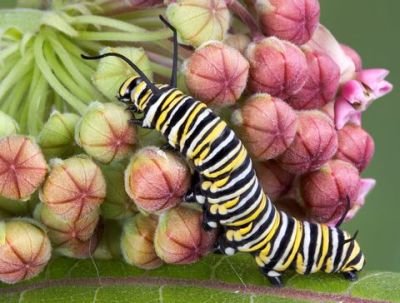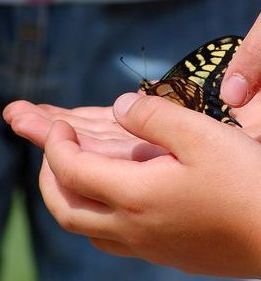How to Raise Butterflies

Learning how to raise butterflies may take some patience and practice. If finding the first attempt may not have gone as planned... try, try again!
Once getting the hang of it, watching the butterfly life cycle is awesome and releasing the flying butterfly back into nature is a rewarding feeling.
1) What needs to be thought about:
Caterpillars are warmed or cooled by air temperatures and either by sun or shade. Keep rearing container out of direct sunlight, to not over-heat caterpillar.
- If inside, make sure it is an area that won't be disturbed by pets, people and insects (insects can kill the caterpillar and the butterfly pupa). Not only should direct sunlight be avoided, avoid a cold environment, such as by air conditioning vent.
- If outside, keep rearing container in a very safe environment away from threatening elements, such as rain. Rain will kill the larva.
Two necessary elements needed on how to raise butterflies:
- Host plants, whether on personal property or from the park, cleaning will need to be done weekly, sometimes sooner.
- Nectar sources with the blooming flowers, fruit or both.
There is a responsibility when learning how to raise butterflies. Although it is possible to go to the park looking for butterflies, it is important to keep in mind that the caterpillar frass requires constant cleaning. Having host plants close by makes cleaning easier. Also important, not just any host plant, depending on butterfly species.
It is also good idea to have nectar sources close by giving butterfly needed energy.
- Emerging butterflies need energy fast.
- Female need nectar after depositing eggs.
2) Supplies Needed:
When raising butterflies supplies can be purchased from the store or made from items found at home.
- When catching a butterfly/caterpillar: A large brown paper bag or box that has plenty of ventilation holes so the butterfly can get air. A butterfly net can also be an option but remember plenty of twigs and leaves are needed to create a natural environment for them to live.
- Rearing containers for pupa/caterpillar: These can be a large jar or small, clean aquarium. Keep in mind that caterpillars will need to crawl and glass makes this task harder.
Large plastic containers with a wide opening on the top can be a better option over glass. If using a soda bottle, cut the top off. If a member of a warehouse club, containers like these are everywhere, like the pretzel isle. - Ventilation for top of container: Cheese cloth, smooth mesh wire. If using a container that has a plastic or metal lid, don't punch holes in and use.
This for two reasons:
1) Doesn't provide enough ventilation.
2) Caterpillars are fragile. If there is a sharp edge on the lid
a caterpillar climbing across that can get injured or killed. - Securing tools: Rubber bands or string can be used to secure cheese cloth.
- Cleaning materials: Paper plates, paper towels.
- Field Guide to help identify butterfly/caterpillar species. If not familiar on how to raise butterflies, raising Monarch butterflies is probably the easiest since they are found throughout North and South America. They are easier to identify and their only host plant is various types of milkweed plants.
Be creative and remember that you will need to get in and out of habitat frequently to clean frass, or caterpillar excrement.
3) Four ways to find butterfly sources:
- Butterfly Egg. Not recommend unless you see butterfly deposit egg or you are certain of the butterfly egg type - you may bring the egg of something back that could be bad for you and your environment.
- Caterpillars. This is likely to be safest and surest bet how to raise butterflies. This is what we will focus on.
- Butterfly Pupa. Whether you find a butterfly pupa or moth cocoon, it can still be fun to watch the life cycle process of each.
- Fertilized female and after she deposits egg, release her.

When looking for caterpillars outside look
under leaves, on stems and flowers.
Once butterfly caterpillar is found, look over all branches and make sure there are no other insects on them. Any unwanted insects could injure or kill caterpillar.
If you don't recognize caterpillar types, consider the butterfly host plants they were found on. Transport caterpillar back to your rearing location with plenty of leaves and twigs from the plant found on.
- Get caterpillar on twig and place it in breathable box or paper bag container that you will be transporting it in.
- Don't drop it - caterpillars are delicate and it will probably die.
- Don't touch caterpillar. Safety is paramount when learning how to raise butterflies. You would introduce caterpillar to a foreign environment (you) that could pass undesirable bacteria to it or caterpillar could be poisonous to you.
Time to Learn How to Raise Butterflies:
Repeat the same careful process when placing butterfly caterpillar in its new habitat. Some helpful tips include:
- It's important to always have fresh twigs and leaves. The leaves are where the caterpillar gets their needed water. Suggestions for keeping host plant vegetation longer include -
1) Wrap vegetation in damp paper towels.
2) Small tube that a flower can come in with the lid on.
Be very careful using a small inconspicuous vase. If the caterpillar falls into water, it will die. Put strong plastic over the opening. - The caterpillar will produce lots of frass, or excrement. This is where the paper towels or paper plates come in. If just learning how to raise butterflies - practice makes perfect. Discover the method that works best for you. One suggestion is to place a stack of paper plates at the bottom and remove the top one when cleaning, displaying the new and fresh plate on top.
When cleaning habitat, avoid moving or touching twig
caterpillar is on so no harm comes to it.
Every time caterpillar molts, or sheds old skin to replace with a new one, it's likely they will look for a place to pupate. Many times the caterpillar crawls up and hang from the top of container. Be very careful not to touch caterpillar.
Once Caterpillar molts for last time and is hanging in its pupa, or third stage of butterfly metamorphosis, there is no need to clean habitat to feed caterpillar anymore. Leave habitat alone and be very careful not to disturb. Keep in mind different butterfly species remain in pupa for different lengths of time, including those that remain dormant, or 'over-winter'. Be patient!
Do mist pupa occasionally.
Once butterfly emerges from its pupa give it time for the wings to fill with hemolymph, or butterflys blood.

Release butterfly back into nature but make sure to have nectar sources close by.
Butterfly needs energy otherwise it risks dying.
The last detail on how to raise butterflies is providing pollen from the flowers or ripe, room temperature fruit. Both provide nectar. If placing fruit out, put knife slashes in the fruit to get the juices flowing. Don't cut fruit into lumps. Butterfly wings can get sticky, which is not good for them.
FYI:
- Studies show that butterflies really enjoy room temperature watermelon, especially the Monarch Butterfly. Monarchs flog
their proboscises in air full of anticipation for the treat! Good
to know if raising monarch butterflies. - Caterpillars breath through spiracles, or tiny holes found along their sides. The goal is to keep rearing container humid, but not wet, because the caterpillar loses moisture. Place moist paper towels in habitat or mist regularly. Don't over-mist, this as it can promote mold.
Related Articles:
Back from How to Raise Butterflies to Easy Butterfly Garden.com
 Copyright © 2010-2022 Easy-Butterfly-Garden.com
Copyright © 2010-2022 Easy-Butterfly-Garden.com
Privacy Policy Disclaimer

Join Easy Butterfly Garden on Facebook
Recent Articles
-
Annual Bluegrass
Jan 14, 17 08:14 PM
Annual bluegrass (Poa annua) is considered a weed in the Poa family, which has a few popular turf grasses. If this gets into your butterfly garden listed are a few ways to eradicate it.
-
Candytuft Flowers
Sep 25, 16 10:54 PM
There are the annual, or Iberis, candytuft flowers and also perennials which are called Iberis sempervirens.
-
Keeping Deer Out
Sep 19, 16 01:10 PM
Reviewing the types of products available for keeping deer out of our gardens along with building fences. Many of these products help with other garden pests.
-
Butterfly Meadows
Sep 19, 16 12:52 PM
Compared to other wildlife gardening, butterfly meadows take time and are not for the faint of heart.
-
Natural Gardening
Sep 19, 16 12:32 PM
Natural gardening includes different types of gardens. These garden types create a casual, natural envirionment and help sustain native wildlife which includes butterflies.






New! Comments
Have your say about what you just read! Leave me a comment in the box below.